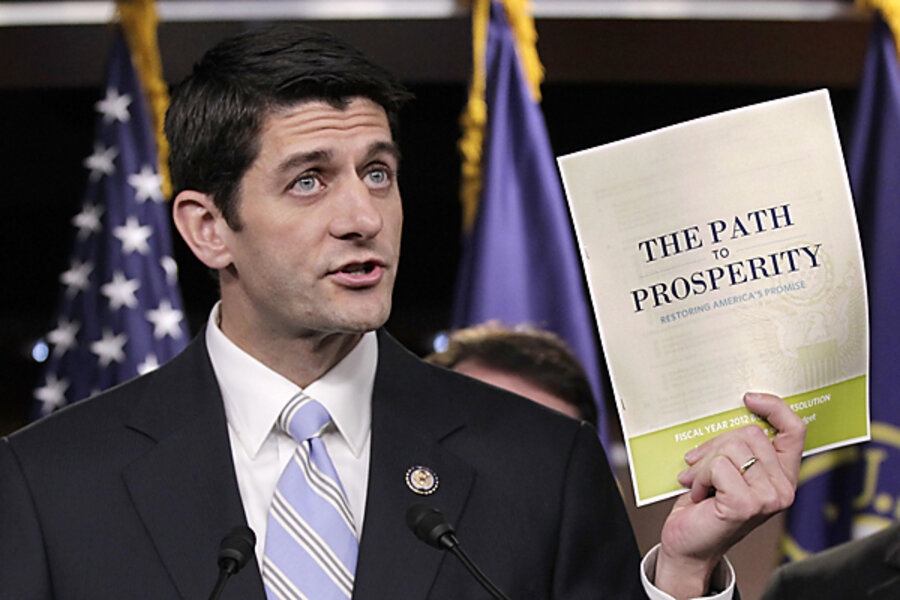House budget plan leaves some big questions
Loading...
If you view a budget as a vision of government, the House GOP’s fiscal map unveiled today charts a profound course correction for Washington and its relationships with both its citizens and the states. In this new world, individuals and families would receive only limited assistance from government in times of stress, but they also might pay much less in taxes than under the status quo.
In stark contrast, President Obama’s February budget envisioned a government hardly different than the one we have had for decades.
According to the fiscal plan drafted by House Budget Committee Chair Paul Ryan (R-WI), federal spending would be almost $1 trillion less in 2021 than if fiscal policy stays on its current track. That is a staggering 20 percent cut, even before the House Republicans biggest proposed change—the repeal of Medicare as we know it—would begin to kick in.
At the same time, tax revenues would be cut by about $600 billion from the Congressional Budget Office baseline for 2021. And the deficit that year would be about $400 billion, roughly $350 billion lower than if government spending remained on course.
This is a big deal. But the budget document is a curious mix of the general targets normally set by a budget resolution and very specific policy proposals. As such, the House GOP leaves unanswered some very important questions. As you think about what Ryan & Co. are doing, here are some to keep in mind:
What exactly is the tax plan? The budget sets only two targets: The federal government should raise no more than 19 percent of Gross Domestic Product in taxes and other revenues. And the top tax rate for both individuals and corporations should be 25 percent. Beyond that, it is a black box. The fiscal plan says nothing about payroll taxes or estate taxes, and almost nothing about taxes on capital gains and dividends. It calls for repealing or scaling back tax preferences, but does not say which ones or by how much. Watch how the House Ways & Means Committee fills in these extremely controversial blanks.
Medicare would be replaced, but with what? The budget plan would dump Medicare for a voucher system where seniors would get an annual subsidy to buy health insurance in the private market. But today, it is not possible for most seniors, who likely have pre-existing conditions, to buy insurance as individuals. For many, premiums would simply be unaffordable even with a government voucher. They could purchase under the 2010 health law that creates insurance exchanges and requires carriers to sell coverage to all comers no matter their health. But the Republicans want to repeal that law and won’t say how they’d replace it.
What will happen to health and long-term care services care for the poor? The GOP plan would turn Medicaid into a kind of voucher as well, except a limited annual subsidy would go to states, and not to individuals. In that environment, states would get increased flexibility, but they’d also have far less money to work with–hundreds of billions of dollars less. The probable result: significant cuts in a program that is already insuffficient in many states. What would happen to the sickest and poorest in that environment?
Wither Social Security? The plan drops this hot potato onto Obama’s lap. It requires the President to come up with a plan to “restore balance” to the system but offers few specific ideas.
Is it really possible to cap federal spending at below 20 percent of GDP? Most economists doubt it, given a rapidly aging population and inevitable economic slumps and natural disasters.
Make no mistake, this plan is a dramatic—some would say radical—change in the role of the federal government. It is curious: Republicans spent two years blistering Obama for his supposedly extreme political agenda. Yet the president is very much a liberal incrementalist. Rhetoric aside, his health law fiddled around the edges of the same private insurance-based health system we have today. His response to the economic crisis was little different from President George W. Bush’s. And despite the demands of the left, the White House recipe for reducing greenhouse gases has been modest at best.
Real change, like the direction or not, is alive and well in Washington. But it is thriving at the other end of Pennsylvania Avenue. I anxiously await Obama’s response.
Add/view comments on this post.
------------------------------
The Christian Science Monitor has assembled a diverse group of the best economy-related bloggers out there. Our guest bloggers are not employed or directed by the Monitor and the views expressed are the bloggers' own, as is responsibility for the content of their blogs. To contact us about a blogger, click here. To add or view a comment on a guest blog, please go to the blogger's own site by clicking on the link above.





